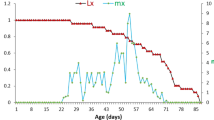Summary
Optimal clutch size of the chestnut gall-wasp,Dryocosmus kuriphilus Yasumatsu (Hymenoptera: Cynipidae), was examined in galls on wild and resistant chestnut trees in 1988 and 1989. The rate of escape success of newly-emerged adults from galls was an average of 60%, irrespective of cell numbers per gall. Dry mass per cell of a gall (as an index of nutritive condition) decreased with increasing cell number per gall, but was proportional to the mean number of mature eggs of new adults per gall. The number of cells per gall that occurred most frequently did not agree with that attained by the maximum survival rate from young larva to adult emergence of the gall-wasp. This discrepancy was examined from the viewpoint of three factors: 1) quality of offspring, 2) defensive response of the host plant causing mortality of the gall-wasp before cell formation, and 3) fitness per gall vs. fitness per egg. It is concluded that the third factor is most likely to be the one best in explaining the discrepancy.
Similar content being viewed by others
References
Fukuda, G. and S. Okusiro (1951) The study about the resistance of chestnut breeds againstDryocosmus kuriphilus Yasumatsu (Hymenoptera: Cynipidae). I.Appl. Zool. 16: 147–156. (in Japanese)
Godfray, H. C. J. (1986) Clutch size in a left-mining fly (Pegomya nitritarsis: Anthomyidae).Ecol. Entomol. 11: 75–81.
Ikawa, T. and Y. Suzuki (1982) Ovipositional experience of the gregarious parasitoidApanteles glomeratus (Hymenoptera: Braconidae) influencing her discrimination of the host larvaePieris rapae crucivora.Appl. Entomol. Zool. 17: 119–126.
Itô, Y. (1967) Population dynamics of the chestnut gall-wasp,Dryocosmus kuriphilus Yasumatsu (Hymenoptera: Cynipidae). IV. Further analysis of the distribution of eggs and young larvae in buds using the truncated negative binomial series.Res. Popul. Ecol. 9: 177–191.
Itô, Y., M. Nakamura, M. Kondo, K. Miyashita and K. Nakamura (1962) Population dynamics of the chestnut gall-wasp,Dryocosmus kuriphilus Yasumatsu (Hymenoptera: Cynipidae). II. Distribution of individuals in bud of chestnut tree.Res. Popul. Ecol. 4: 35–46.
Iwasa, Y., Y. Suzuki and Y. Matsuda (1984) The oviposition strategy of parasitoids. I. Effect of mortality and limited egg number.Theor. Pop. Biol.,26: 205–227.
Kato, K. and N. Hijii (1989) Population dynamics of the chestnut gall-wasp,Dryocosmus kuriphilus Yasumatsu (Hymenoptera: Cynipidae) on wild chestnut trees (I). Death of the emerged adults inside galls. 571–572. InTrans. 100th Mtg. Jpn. For. Soc. (in Japanese)
Miyashita, K., Y. Itô, K. Nakamura, M. Nakamura and M. Kondo (1965) Population dynamics of the chestnut gall-wasp,Dryocosmus kuriphilus Yasumatsu (Hymenoptera: Cynipidae). III. Five year observation on population fluctuations.Jap. J. Appl. Ent. Zool. 9: 42–52.
Nitto, M. and K. Tachibana (1956) Influence of the wind on the dispersion of the chestnut gall wasp.Bull. For. For. Prod. Res. Inst. 83: 89–97. (in Japanese).
Okudai, S. (1956) Studies on the resistance of chestnut varieties to the chestnut gall wasp (Dryocosmus kuriphilus Yasumatsu). 2.Hortic. Div. Tôkai-Kinki Agric. Exp. Stn. Bull. No. 3: 85–92. (in Japanese with English summary)
Ōtake, A. (1980) Chestnut gall wasp,Dryocosmus kuriphilus Yasumatsu (Hymenoptera: Cynipidae): a preliminary study on trend of adult emergence and some other ecological aspects related to the final stage of its life cycle.Appl. Ent. Zool. 15: 96–105.
Parker, G. A. and S. P. Courtney (1984) Models of clutch size in insect oviposition.Theor. Popul. Biol. 26: 27–48.
Shiragami, T. (1951)Dryocosmus kuriphilus Yasumatsu (Hymenoptera: Cynipidae) and its protection.Nougyou Oyobi Engei (Agriculture and Horticulture) 26: 167–170. (in Japanese)
Stinner, B. R. and W. G. Abrahamson (1979) Energetics of theSolidago canedensis stem gall insect-parasitoid guild.Ecology 60: 918–926.
Tamura, M. (1959) Studies on the chestnut gall wasp,Dryocosmus kuriphilus Yasumatsu. (Part 2) About the life cycle.J. Agric. Sci., Tokyo Nogyo Daigaku 6: 13–26. (in Japanese)
Tamura, M. (1965) Ecology ofDryocosmus kuriphilus Yasumatsu (Hymenoptera: Cynipidae).Shinrin-Boueki News 14: 80–84. (in Japanese)
Waage, J. K. (1986) Family planning in parasitoids: adaptive patterns of progeny and sex allocation. 63–95. In Insect Parasitoids, ed. J. Waage & D. Greathead, Acdemic Press, London.
Weis, A. E., P. W. Price and M. Lynch (1983) Selective pressure on clutch size in the gall maker,Arteomyia carbonifera.Ecology 64: 688–695.
Author information
Authors and Affiliations
Rights and permissions
About this article
Cite this article
Kato, K., Hijii, N. Optimal clutch size of the chestnut gall-wasp,Dryocosmus kuriphilus yasumatsu (Hymenoptera: Cynipidae). Res Popul Ecol 35, 1–14 (1993). https://doi.org/10.1007/BF02515640
Issue Date:
DOI: https://doi.org/10.1007/BF02515640




